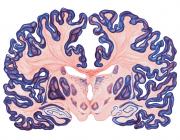Topographic maps in human frontal cortex revealed in memory-guided saccade and spatial working-memory tasks.
Publication Year
2007
Type
Journal Article
Abstract
We used fMRI at 3 Tesla and improved spatial resolution (2 x 2 x 2 mm(3)) to investigate topographic organization in human frontal cortex using memory-guided response tasks performed at 8 or 12 peripheral locations arranged clockwise around a central fixation point. The tasks required the location of a peripheral target to be remembered for several seconds after which the subjects either made a saccade to the remembered location (memory-guided saccade task) or judged whether a test stimulus appeared in the same or a slightly different location by button press (spatial working-memory task). With these tasks, we found two topographic maps in each hemisphere, one in the superior branch of precentral cortex and caudalmost part of the superior frontal sulcus, in the region of the human frontal eye field, and a second in the inferior branch of precentral cortex and caudalmost part of the inferior frontal sulcus, both of which greatly overlapped with activations evoked by visually guided saccades. In each map, activated voxels coded for saccade directions and memorized locations predominantly in the contralateral hemifield with neighboring saccade directions and memorized locations represented in adjacent locations of the map. Particular saccade directions or memorized locations were often represented in multiple locations of the map. The topographic activation patterns showed individual variability from subject to subject but were reproducible within subjects. Notably, only saccade-related activation, but no topographic organization, was found in the region of the human supplementary eye field in dorsomedial prefrontal cortex. Together these results show that topographic organization can be revealed outside sensory cortical areas using more complex behavioral tasks.
Keywords
Journal
J Neurophysiol
Volume
97
Pages
3494-507
Date Published
05/2007
ISSN Number
0022-3077
Alternate Journal
J. Neurophysiol.
PMID
17360822

